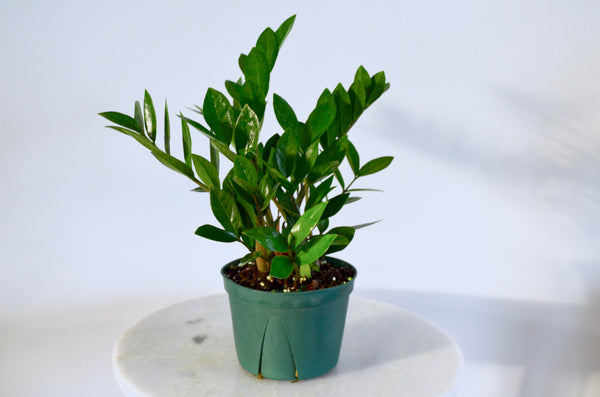ZZ Plant: Houseplant Guide (with Care, Bio, & Unique Facts)

Reliable, sturdy, and low-maintenance, the ZZ plant is a houseplant winner across the board. From beginner plant parents to experienced flora fiends, the ZZ plant makes a great indoor plant for every level. The plant's flexibility in terms of basic needs is what really draws appeal— as it can tolerate various conditions like a dim corner or a bright entryway. These easy-going traits make the ZZ plant fit in well in offices, bathrooms, and as a gift.
Scientific Name: Zamioculcas zamiifolia
Origin: Eastern Africa
About:
The ZZ plant, also referred to as the Zanzibar gem, features thick stalks sprouting from the soil— each branch displaying deep green, upwards pointing, glossy, oval leaves. It’s considered an easy to care for (and even “hard-to-kill”) plant. Basically, just place this plant in any room (with at least some light, because all plants need sun), and let it be for weeks. Many say this plant “thrives on neglect”. We do not condone neglecting your plant babies, so we’re taking it upon ourselves to reword that colloquialism as “thrives on independence”.
Descending from arid regions of Africa, the ZZ plant is actually drought-tolerant and fascinatingly stores water within its tubers. Which explains that independent nature. While this plant can withstand long periods without water, that isn’t always the case when contained in a pot indoors.

Indoor Care:
Compared to other houseplants, the ZZ plant can go longer between waterings and is often tougher, with the ability to bounce back quickly. But it should be noted that this plant will prefer watering every 2-8 weeks (depending on the season, sunlight exposure, etc.). As a general rule, when it’s warmer, sunnier, drier, the plant will require more moisture.
Sun
What makes the ZZ plant so special is its adaptability and versatility. This plant can handle low to bright light, but does not enjoy direct sun exposure (which could cause leaf burns). While you can pretty much place it anywhere in your space that has at least some natural light, it will do best in a higher light spot.
Water
Since this plant is capable of storing extra water, you’ll want to only water once the soil is dry. You can check by wiggling a finger through the bottom holes of the pot to measure for moisture. When you water the ZZ plant, make sure that you’re doing so thoroughly— allow water to drain all the way through the bottom holes of the pot. This method of watering ensures that the entire root system is receiving vital nutrients.
It’s important not to overwater the ZZ plant, so make sure that there’s no standing water left over. If this plant is exposed to too much moisture, it could waterlog the rhizomes beneath the soil, and even lead to root rot.

Extra Care & Growth:
Traditionally considered a slow grower, with the right conditions, the ZZ plant can actually grow quickly for an indoor plant. This indoor plant can eventually get to 4 feet high and 4 feet wide! For optimal growth, place it in a brightly lit spot (out of direct sunlight), and water once the soil is almost dry throughout. Again, never overwater! Your plant can usually come back from underwatering, but it’s much harder (sometimes impossible) to bounce back after too much water.
This plant will also appreciate a dose of fertilizer in the spring to thrive to its fullest potential. If it is starting to outgrow its current pot, consider repotting your ZZ plant a size up (2 inches larger is usually sufficient). Repotting may need to be done once a year in the spring or summer if the plant is continually growing.
In addition, as new growth comes in, it is common for lower leaves to yellow. It’s completely normal, so simply, pluck away the yellow leaves.
Pests
ZZ plants have no recorded experience with pests. They’re also resistant to disease. Another box checked on this all-around MVP (most valuable plant).
Toxicity: Considered slightly toxic when ingested by humans, cats, and dogs.
Buy Online: ZZ plant— 6 Inch